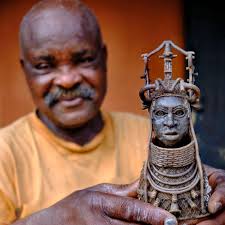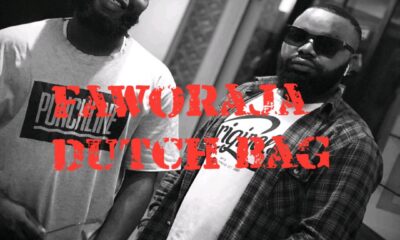History
Who is Khayzuran – The First Woman to rule in Islamic History.


Born in Yemen, Khayzuran was captured as a slave and brought to the palace of Caliph al-Mahdi in Baghdad, the seat of the Abbasid Empire that ruled the Islamic world from the 8th century until 1258, when the Mongols conquered the city. If you don’t know much about Baghdad other than what you’ve heard on the news in recent years, wipe your mind free of those perceptions and begin again in the year 775, as al-Mahdi came to power, the third Abbasid caliph.
Baghdad in this time, and for centuries after, was lit.’ Well-regulated markets offered trade from India, China, and basically everywhere else. People came from all over and shared scientific and literary knowledge. Baghdad has from its start been book-obsessed. Educated Baghdadi citizens frequented libraries and bookstores and read works from around the world translated to Arabic in one of the translation schools of the city.
Listen and download Nigeria Before 1999 by Living Soul
Listen and download Irene Ministry Divine Hour of Visitation
Ads

Now forget what you think you know about harems. If you have vague memories of the word or paintings of women lolling about half-naked, know that these images come from the minds of horny white European men, the kind of men who nowadays visit a Middle Eastern country for a week and thenceforth hold court in all social gatherings about the mysteries of the Orient.
In reality, the harem was the private sphere of women in an imperial court, and was a highly political place. Quite a few powerful women who started out as slaves in the harem but ended up ruling empires through the work of their own wits, their alliances, their education, their skill at political intrigue, and, sure, their beauty.
Ads
http://Say goodbye to unnecessary subscription
When Khayzuran was brought to the palace at Baghdad, her impoverished family came with her, and their fate would be altered beyond their wildest imaginings.
Khayzuran became the wife of al-Mahdi, and manoeuvred their sons to be named his heirs in spite of an earlier marriage. As the wife of the caliph, Khayzuran was an active and public face of state affairs, and arranged excellent positions in government for her much-elevated family.
When al-Mahdi died in 785, Khayzuran’s two sons were away from Baghdad, but she acted quickly to assert her family’s claim to power. To quell any unrest in a sudden power vacuum, she disbursed two years of pay to the army. You wouldn’t be interested in a coup if you’d just received two years’ salary, would you?
Khayzuran called back her sons, and arranged for dignitaries and power brokers to swear allegiance to the elder son, al-Hadi.
Unfortunately for all involved, al-Hadi turned out to be a garbage son. (There’s one in every family, and if you don’t know who yours is, it’s you.) He was also jealous of his younger brother, who was obviously and better liked than he. Al-Hadi felt very threatened by his mother, who had cultivated a powerful network of advisers and officials who visited her regularly in the palace. ‘It is not in the power of women to intervene,’ he had the nerve to say to his own mother who birthed him, ‘in matters of sovereignty. Look to your prayers and your prayer beads’.
Well, instead of looking to her prayer beads, Khayzuran may have gotten involved in murdering her son instead. Was it her who did it? Who’s to say! Whoever it was, they may have sent sexy ladies to his bedroom to girlishly smother him with pillows, putting a sexy end to al-Hadi’s rule after just over a year.
It seems that al-Hadi had probably been plotting the deaths of his mother and brother. Once, he sent his mother food with instructions for her to ‘eat it up because it’s sooooo soooo yummy!’ but she fed it to her dog first, who promptly died. So better to get in there first when you’re playing the murdering game, I suppose.
And so Khayzuran’s second son, Harun, came to power. Khayzuran continued managing her own affairs of state just fine, and Harun trusted his mother for advice in matters of policy. He happily divided responsibilities and power with her, and presided over a glorious court.
Source – ‘100 Nasty Women of History’ by Hannah Jewell
Ads




History
How the name ‘Ilorin’ was derived.


Hundreds of years ago, there was a forest called Oko-Erin, there were many elephants in this bush, that was why it is called Oko-Erin [elephant forest], only the brave and powerful hunters live in this forest. Òjó Oníṣekúṣe [Ojo the promiscuous], who was from Ijesha, was the first hunter to arrive Oko-Erin he was a brave and powerful hunter. Ẹ̀mìńlá from Ìlá- Ọ̀ràngún also came and met Òjó Oníṣekúṣe in this forest; he was a powerful hunter too.
Both Òjó Oníṣekúṣe and Ẹ̀mìńlá do not live at Oko-Erin, they only hunt for a while and return to their family. Ọláderin arrived Oko-Erin after Ẹ̀mìńlá and Òjó Oníṣekúse. Ọláderin has a hut in this forest; he was the leader of all the elephant hunters at the time and he was the first settler at Oko-Erin. He was from Oyo Alaafin. Whenever his co-hunters returns from hunting, they took some rest at Oladerin’s hut, Oladerin was so powerful that both humans, elephants, and other animals fear him.
Read also
Who is Khayzuran – The First Woman to rule in Islamic History.

Laderin has a big pot of concoctions, when he enters this pot, he can turn into any type of animal he desires. That was why he was referred to as Ola di erin [Oladerin.] There was a stone used for sharpening their machetes at Oladerin’s hut, whenever their machetes got blunt; they took it to Oladerin’s hut to sharpen it on this particular stone. while heading to Oladerin’s hut to sharpen their machete, if anybody asks them where they are going, they would say “mò ń lọ lọ irin mi lọ́dọ̀ọ Láderin” [I want to go and sharpen my machete at Laderin’s place] they used to call this stone Ìlọ irin [a sharpener]Ilorin derived its name from this stone.
The stone they used for sharpening their machetes is still at Bámidélé house in Ilorin today. Ojo onisekuse was said to have fled Oko-Erin because of his promiscuity, he was fond of sleeping with his daughter and family, and this act is forbidden when he was caught, he had to flee Oko-Erin. Eminla went back to Ila-Orangun.
History
Ile Ife (Aftermath of Modakeke war)


With the fall of the Oyo Empire to the Fulani, the Yoruba kingdom was thrown into confusion and the inhabitants of the Old Oyo were dispersed and started new settlements all around Yoruba land.Fleeing southwards in search of new abodes after the fall of the Oyo Empire, the Oyos started settling among the Ifes in 1834. As the Romans of old, they were soldier-farmers. They were hardy as soldiers and industrious as farmers. Having lost all their possessions in their hasty flight, they started life in Ife by doing menial jobs to enable them eke out a living. The reigning Ooni of Ife, Oba Akinmoyero was said to have received them well. They started growing and producing different types of food crops on farmlands given to them by their hosts. A good number of them got recruited into Ife’s weak army and it was through their gallantry that Ife had its territory extended to Alakowe, its present boundary with Ilesa. Prior to the arrival of the Oyos, Ijesha land extended to the present location of the Palace of the Ooni of Ife. This is why the Palace area is known as Enuwa (Enu Owa) until today.
Read also
THE HISTORY OF OJE MARKET IN THE ANCIENT CITY OF IBADAN

Ooni Akinmoyero gave the displaced Oyo an expanse of land to stay outside the walls of Ife,the place given to the Modakekes was home to a species of bird called Ako (Stork), Hence the origin of the appellation AKORAYE(The stork found a space). It was also customary for the storks at the location to chirp and sing the rhyme “Mo-da-ke-ke-ke-ke” which was most of the time heard by the Ifes and it was decided that the new settlement would be called MODAKEKE.
History
Who is Yoruba?


When the Awujale of Ijebu Òde said sometimes ago that Ijebu not Yoruba many people thought Kabiesi wasn’t right, but Aláàfin Ọ̀yọ quickly went to visit him he even went with danofijo a popular Masquerade of Ọ̀yọ́ town to entertain Awujale, a smart moves by Kabiesi Aláàfin.
My late father (Olowoporoku)
always corrected me anytime I refered to myself a Yoruba (ṣe ara Ọ̀yọ́ ni ẹ ni) are you from Ọ̀yọ́ town? He will said to me.
Baba told me that Yoruba is the name the Gogobiri (Gambari of the North) called Oyo people, the name became popular during the era of Alaafin Abiodun Adegolu bcos of he’s peaceful and long rein, Ọ̀yọ́ people were the Yorubas proper.
Ẹ̀gbá, Ìjẹ̀bú, Ifẹ̀, Rẹmo, ijesha, Èkìtì, Ondo, Ketu, Ùgbó and Ibini were not part of Yoruba.
We are all connected to Ile Ifẹ that’s why we speak same Language but we are not all Yorubas until 1919/1920.
Read also
THE HISTORY OF OJE MARKET IN THE ANCIENT CITY OF IBADAN

The adoption of Yoruba name was part of colonial legacy.
Between 1901- 1904 there was a war between Awujale of Ijebu Òde and Akarigbo of Isagamu the war was serious to an extent the British was unable to curtail it,
then the British always thought that Aláàfin was the head of all the Obas bcos it was the Aláàfin that invited them to Yorubaland during the kiriji war, they sent message to Aláàfin for intervention Aláàfin sent his Staff of office to the seat of war but the messengers were chaced away.
The British were loosing money and goods from interland because war between the two major people to the Port was damaging the British economic interest… goods can’t reach Lagos Port via Isagamu/Ikorodu and Ijebu Òde /Ẹpẹ.
The Aláàfin adivised them meet the Ọọni of Ifẹ instead.
The British quickly rán to Ọọ̀ni to rescue the situation, then it was a taboo for Ọọni of Ifẹ̀ to leave the palace or Cross water , after a long beggins the iwerefa of Ifẹ̀ agreed to let the Ọọni set aside the tradition for peace to rein with heavy fine for the sacrifces by iwarefas the British agreed to be responsible, then for the first time in the history Ọọni of Ifẹ̀ left he’s palace.
The day the Ọọni of Ifẹ̀ left his palace, Baba told me that all the Ọbas and Baalẹs in Yoruba land including Ọba of Benin and Aláàfin of Ọ̀yọ́ vavated their palace to honor the tradition, the Awujalẹ and Akarigbo order their army to seize fire when they heard the coming of Ọ̀ọni of Ifẹ̀. That was how powerful the trandition was.
After the war, the British started the process to weaknening the Yoruba people and traditional bonds, they finally called the meeting of the first class traditional rullers to adopt ‘Yoruba’ as a common name, but the Awujalẹ of Ijebu ode, Ọ̀ọni of Ifẹ̀ and Oba Benin rejected the name but the British had there way.
That is the smartest way to control us as a whole.
So if the Aláàfin Ọ̀yọ́ said he is the only King that have the power to confer title of Yoruba on anyone he might be right bcos the Yoruba name belongs to Ọ̀yọ́ people.
Its part of colonial hangover!
Iba Bába mi.
Iba àwọn àgbà!
– RUTH WORLDBEST
#Ruthworldbest #tvauthority
-

 Metro5 months ago
Metro5 months agoSanwo-Olu personal graveyard spotted in Ikoyi (photo)
-

 Entertainment6 months ago
Entertainment6 months agoJunior Pope is alive – MC Mbakara
-

 Entertainment6 months ago
Entertainment6 months agoDownload Faworaja Dutch Bag by Twinz-b mp3
-

 Entertainment6 months ago
Entertainment6 months agoJunior Pope: Survival narrates how the boat capsized (Video)
-

 Sports6 months ago
Sports6 months agoMoment Ibadan ace sports caster boarded flight and landed ahead Super Falcons clash in Abuja
-

 Fashion6 months ago
Fashion6 months ago$20 Million World most expensive shoes and other expensive footwears
-

 Business6 months ago
Business6 months agoBREAKING: First Bank MD set to embark on pre-retirement leave
-

 History5 months ago
History5 months agoListen and download Nigeria Before 1999 by Living Soul


















